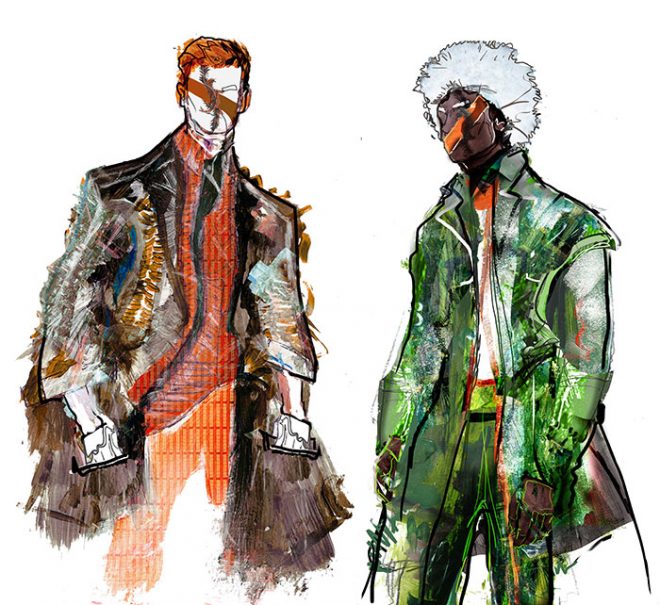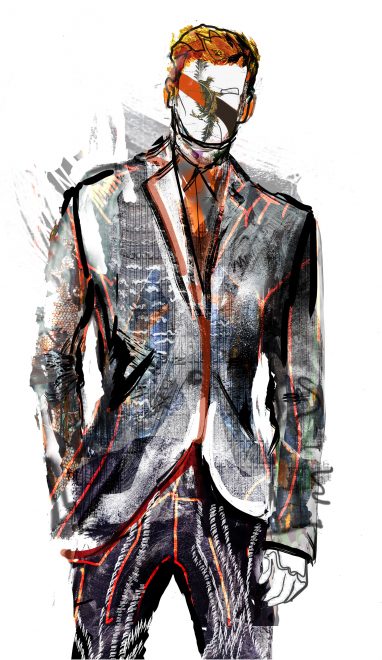I’m extremely excited to be tutoring the Styling the Nation fashion illustration workshop; I really believe anyone can draw with enough practice and enough creative freedom.
If the talk of fashion, drawing and illustration inspires you, then come along to the free session this weekend (12 – 13 November), from 11:00 to 16:00 at the National Museum for Scotland. Experiment with new materials, hone your existing skills and join in a vibrant and creative weekend.

To give some background on me, I recently completed my BA (Hons) Fashion degree at Edinburgh College of Art with a first class honors and now I am progressing through my masters degree at Edinburgh University. I gained and took up internships for Burberry (London) for the GFW Burberry award 1st place, H&M (Sweden), Rochambeau (New York) & Patrik Ervell (New York) and enjoyed competitions such as Mackintosh (1st place), Michael Kors (2nd place) and Diversity Now (shortlist finalist 2014 & 2016). Edinburgh has been the perfect grounding for opportunity and allowed me to mix my interests of Scottish history, futuristic film, painting and connecting with industry and artisans. As a result of the experimental and innovative nature of studying at Edinburgh, I have had time and practice to develop a distinct illustration style and further my passion for drawing. To achieve this look, or indeed to find your own style, below are some practices and methods that can help form solid foundations in fashion illustration.
Use a variety of materials
Diversity of materials makes drawing more exciting and dynamic. Don’t be afraid to empty your pencil case and grab the first material that comes to hand. Mixing acrylics with pen, and pencils with chalk pastels, charcoal with watercolour – try out different combinations and see what best suits you, what feels most free and which materials marry up naturally to you. It will be different for everyone, however, that’s the fun. Being instinctive and making mistakes in drawing in this experimental way can only be a good thing: learn from it and then edit in and out new materials until you find your recipe.
Draw Big
Free yourself up and draw on A3 or larger. Think of impact, think of scale, work on big drawings for five minutes or five hours, but draw big. It really gives a sense of perspective and can create really dynamic work. By beginning this way your sense of proportion is heightened, as you have space and room to breathe. The drawings can then be shrunk down in digital formats later on if you wish, but to draw big adds in more fun, which is hugely productive for development.
Free up your drawing
Don’t get caught in the detail straight away. With my fashion practice it’s all about shape and form; let that continue into the drawing. Start by blocking out the proportions, shape and posture of the body, and use fluid lines to get the position and weight of how the person is posed. It will look nothing like you imagine but don’t worry, it’s the foundation of things to come. Really go for it and draw quick and purposefully; free up with some five minute fashion sketches, get down all the information you need to but then stop yourself at the time limit. It will look like a whirlwind of lines and varied brushstrokes of light and shade but this is your base (long handled brushes are excellent for this, with a light-coloured, natural-toned paint). Afterwards move on to longer poses but work just as quickly and freely; you’ll make your base then begin to develop it and work on and in to it: forms comes first, detail comes next.
 Capturing clothing impressions
Capturing clothing impressions
Capturing the drape of the clothes is similar to the body work that went before it. Use the same techniques you used to map out the body for the clothes, with quick purposeful drawing not focusing on each individual fold or crease but giving the overall impression. Use a different colour perhaps but keep it light. Then work in with light and shade and add more information to the drawing: where the shadows and highlights on the garment are, how it covers or reveals the body.
Texture and colour
Now that you have your model and clothing mapped, it’s time to show your personal style and add colour and texture. This can be done in a variety of ways and mediums. Really it’s up to you to experiment, and depending on the material of the garments this will vary too. In my illustrations, to depict my carbon and lace garments I work with acrylics, charcoal, physical material, digital scans, collage, metallic paints and pens, gouache – my pencil case and toolbox are emptied and it’s a real mix of colours and textures. There’s method in the madness – find yours by discovering all these new and exciting materials, and don’t limit yourself. Show the texture of the fabric, the key details, the print, the embellishment, the silhouette-defining features. The key here is that you don’t have to draw everything. Overworking is easy so hold back too – know when to stop. Don’t worry, I’m still developing that sense too.
Never bin artwork
The Golden Rule – keep everything. No matter how many mistakes you think you’ve made in a piece, that’s the beauty of fashion illustration – you define your style and other people won’t see them as mistakes but as part of the charm of the drawing. The layered drawing method detailed in the tips above encourages colouring outside the lines, overlaid attempts at defining the form and rubbings out. It shows movement, process and energy: that’s what’s exiting about fashion drawing in particular – clothes and people move and you are better able to harness that energy by drawing in a dynamic fashion then by calming and editing. However, if you’re still not satisfied with the piece, use it as a base for another drawing. Perhaps you like the texture in one small part of it – cut it out and use it as part of your own personal library of techniques; record it in a journal or scrapbook with how you achieved it.
Enjoy it
Drawing and painting are fantastic fun and all about finding your own path. Everyone’s hand is different so embrace it and harness your individuality in drawing. The techniques above are a guide; if you find your own path, pursue it! Dip into others techniques, look to contemporary illustrators, look to the Old Masters, look everywhere for inspiration and know that there is no one way. Whether beginner or advanced you are constantly learning, reshaping and re-inventing, taking on board new techniques and editing your methods. Fashion drawing lets you artistically try out new things on the page, there’s no pressure to conform, rather there’s room to explore.
Make sure to join us this weekend for some fun and creativity!
Fashion Illustration Workshops, 12 Nov – 13 Nov 2016, 12:00 – 16:00, the National Museum of Scotland, Free, drop in.
Styling the Nation, 12 Nov – 13 Nov 2016, 11:00-16:00 at the National Museum of Scotland.
Styling the Nation is supported by Event Scotland.
Part of the 2016 Year of Innovation, Architecture and Design.